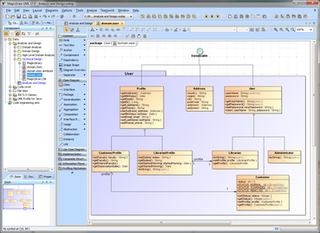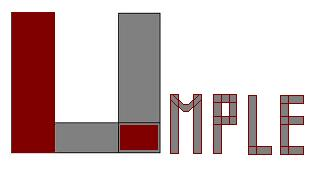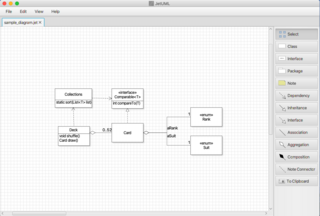
Eclipse is an integrated development environment (IDE) used in computer programming. It contains a base workspace and an extensible plug-in system for customizing the environment. Eclipse is written mostly in Java and its primary use is for developing Java applications, but it may also be used to develop applications in other programming languages via plug-ins, including Ada, ABAP, C, C++, C#, Clojure, COBOL, D, Erlang, Fortran, Groovy, Haskell, JavaScript, Julia, Lasso, Lua, NATURAL, Perl, PHP, Prolog, Python, R, Ruby, Rust, Scala, and Scheme. It can also be used to develop documents with LaTeX and packages for the software Mathematica. Development environments include the Eclipse Java development tools (JDT) for Java and Scala, Eclipse CDT for C/C++, and Eclipse PDT for PHP, among others.
Model-driven architecture (MDA) is a software design approach for the development of software systems. It provides a set of guidelines for the structuring of specifications, which are expressed as models. Model-driven architecture is a kind of domain engineering, and supports model-driven engineering of software systems. It was launched by the Object Management Group (OMG) in 2001.
Round-trip engineering (RTE) is a functionality of software development tools that synchronizes two or more related software artifacts, such as, source code, models, configuration files, and even documentation. The need for round-trip engineering arises when the same information is present in multiple artifacts and therefore an inconsistency may occur if not all artifacts are consistently updated to reflect a given change. For example, some piece of information was added to/changed in only one artifact and, as a result, it became missing in/inconsistent with the other artifacts.

Objecteering is a UML and MDA CASE tool edited by Objecteering Software, a subsidiary of Softeam.
A UML tool is a software application that supports some or all of the notation and semantics associated with the Unified Modeling Language (UML), which is the industry standard general-purpose modeling language for software engineering.
Object-oriented analysis and design (OOAD) is a technical approach for analyzing and designing an application, system, or business by applying object-oriented programming, as well as using visual modeling throughout the software development process to guide stakeholder communication and product quality.

Unicom System Architect is an enterprise architecture tool that is used by the business and technology departments of corporations and government agencies to model their business operations and the systems, applications, and databases that support them. System Architect is used to build architectures using various frameworks including TOGAF, ArchiMate, DoDAF, MODAF and NAF. System Architect is developed by UNICOM Systems, a division of UNICOM Global, a United States-based company.
UMLet is an open-source Java-based UML tool designed for teaching the Unified Modeling Language and for quickly creating UML diagrams. It is a drawing tool rather than a modelling tool as there is no underlying dictionary or directory of reusable design objects. UMLet is distributed under the GNU General Public License.
SAP PowerDesigner (PowerDesigner) is a collaborative enterprise modelling tool produced by Sybase, currently owned by SAP. It can run either under Microsoft Windows as a native application or in an Eclipse environment through a plugin. It supports model-driven architecture software design, and stores models using a variety of file extensions, such as .bpm, .cdm and .pdm. The internal file structure can be either XML or a compressed binary file format. It can also store models in a database repository.
Model-driven engineering (MDE) is a software development methodology that focuses on creating and exploiting domain models, which are conceptual models of all the topics related to a specific problem. Hence, it highlights and aims at abstract representations of the knowledge and activities that govern a particular application domain, rather than the computing concepts.

MagicDraw is a visual UML, SysML, BPMN, and UPDM modeling tool with team collaboration support. Designed for business analysts, software analysts, programmers, and QA engineers, this dynamic and versatile development tool facilitates analysis and design of object oriented (OO) systems and databases. It provides the code engineering mechanism, as well as database schema modeling, DDL generation and reverse engineering facilities.
Rational Rose XDE, an "eXtended Development Environment" for software developers, integrates with Microsoft Visual Studio .NET and Rational Application Developer. The Rational Software division of IBM, which previously produced Rational Rose, wrote this software.
Rational Software Architect is a modeling and development environment that uses the Unified Modeling Language (UML) for designing architecture for C++ and Java EE (JEE) applications and web services. Rational Software Architect is built on the Eclipse open-source software framework and includes capabilities focused on architectural code analysis, C++, and model-driven development (MDD) with the UML for creating applications and web services.

Rational Software Modeler (RSM), made by IBM's Rational Software division, is a Unified Modeling Language (UML) 2.0-based visual modeling and design tool. Rational Software Modeler is based on the Eclipse open-source software framework and is used for visual modeling and model-driven development (MDD) with UML for creating applications and web services. IBM ceased marketing Rational Software Modeler in 2010 and ended support for it in 2015. Much of the same functionality is now available through Rational Software Architect.

UModel is a UML software modeling tool from Altova, the creator of XMLSpy. UModel supports all 14 UML 2 diagram types and adds a unique diagram for modeling XML Schemas in UML. UModel also supports SysML for embedded system developers, and business process modeling for enterprise analysts. UModel includes code engineering functionality including code generation in Java, C#, and Visual Basic, reverse engineering of existing applications, and round-trip engineering.

Umple is a language for both object-oriented programming and modelling with class diagrams and state diagrams. The name Umple is a portmanteau of "UML", "ample" and "Simple", indicating that it is designed to provide ample features to extend programming languages with UML capabilities.

Sparx Systems Enterprise Architect is a visual modeling and design tool based on the OMG UML. The platform supports: the design and construction of software systems; modeling business processes; and modeling industry based domains. It is used by businesses and organizations to not only model the architecture of their systems, but to process the implementation of these models across the full application development life-cycle.

JetUML is a UML tool developed as a pure-Java desktop application for educational and professional use. The project was launched in January 2015 with a focus on minimalist design. The name JetUML relates to the primary goal of the tool, namely fast Unified Modeling Language (UML) diagramming. JetUML is a free and open-source software licensed under the GNU General Public License (GPL).








